

G4DDI
How I got interested
 |
 |
G4DDI How I got interested |
Keeping vintage
radios alive!
|
My interest in radio started when I was about seven or eight. I
discovered that lots of fascinating stations could be received on the shortwave bands of
my parents' Bush radio. My uncle had an interest in radios, and he gave me some bits and
pieces, which included a pair of DLR headphones and a dog-eared copy of a book called
"The Boy Electrician", which was published in 1940. In it I read that radio
signals could be received by winding lengths of wire around pieces of wood, and detecting
them with lumps of coal. After many attempts at this, and getting nowhere, I aquired a
crystal diode. Now, stations came in from all over the world, I particularly remember
Swiss Radio International, with their "Now here is a Swiss watch to give you the
precise time" intro. And of course Radio Moscow.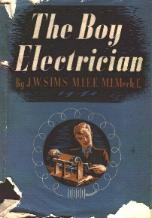
Soon after this, we moved to Boston and my experiments continued, proceeding on to a reaction set using a prized aquisition, a 12AX7 valve, and circuits from "The Boy Electrician". I had by now started a lifelong career of collecting scrap televisions etc. and stripping them down for parts. The LT was supplied using a bell transformer bought from Woolies, with HT derived by rectifying the mains, at first with a metal rectifier, then when that blew up one night, making the whole house stink of rotten eggs, with a valve rectifier, a PY81 I think. I have had an aversion to solid state rectifiers ever since. The receiver was built open plan on bits of plywood etc. I dread to think what my father would have said about it had he had any electrical knowledge at all! Still, I lived to tell the tale.
Trouble was, I kept on receiving this station who couldn't seem to be able to decide if he was in Norway, Mexico or Ontario. To a background of assorted clanking noises he frequently described what his wife was cooking for dinner, or washing up. In conversations about this at school, I eventually discovered that this was an amateur radio station, that he lived just up the road from us, and that he was the father of a boy at our school. This station was Jim, G3NMO, and his son is Paul, now G4VAM.
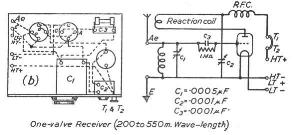
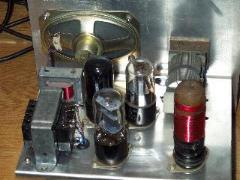
The circuit from "The Boy
Electrician"
A recently built receiver based on this circuit
that inspired me into radio construction.
I began to experiment with transmitters built from bits of the TV sets, and soon managed to communicate with a friend in a neighbouring house. Trouble was, the other neighbours noticed too, and things were said to my parents about noises coming out of their radios and TVs. Now, my mother worked at the Post Office at this time, and I soon received a friendly visit from the local Interference Officer, one Ken Rushton.
Ken kindly advised me and my friend of the error of our ways, gave me a huge heap of books and magazines and explained how one should go about getting a radio licence. Amongst these books was the paperwork from an EMI correspondence course for the RAE, and I studied this intently from one end to the other. Within a few months, I could draw out the complete circuit of a superheterodyne receiver, and explain the action of a low pass filter.(No multiple choice questions in those days)
I took the RAE at the age of fourteen, passed, and got my first licence, G8IEV, in 1973,at the age of 15. (Go on then-work out how old I am)
Now, I had to get on the air on VHF, not so easy, the newly emerging black boxes were well out of reach, as was ex-pmr equipment. I built a converter to a design in Practical Wireless, using 2N3819's, and feeding to my recently aquired 19 set, bought for the extortionate sum of £2.50 plus 37 1/2 p carriage from an advertiser in PW.
The converter was peaked up on the ignition noise from passing cars, and, between the IF breakthrough, I found I could often hear stations "calling CQ and tuning from high to low".
At about this time, I was introduced to the delights of the Spilsby Junk Sale, held then at the "Bull". After pleading with my father to take me there, we returned with the back of the car resting on its bump stops. You know how it is, the auctioneer (G2FT in those days) loads one lot onto the next if there are no takers. Dad made vague mutterings about never taking me there again, but he often did, as, apparently they served a good pint or three of Batemans best bitter there.
Amongst this lot of junk was an SCR522 transmitter, which I stripped down and rebuilt to get myself on 2m, with a 8100 crystal cadged from G3NMO, and an 832A PA modulated with a pair of 6V6's.. Hence the beginning of my use of 145.8 as a working frequency.
I soon had another visit from Mr. Rushton, as apparently I was causing interference to the control station of a local aerial spraying company. I had to demonstrate that my Tx was free of harmonics, as per the terms of the licence, and produce my logbook for inspection and signature. After a few tweaks, the TX was pronounced clean to the satisfaction of the Post Office. Apparently the solid state airband receivers in use then were prone to receiving image signals from the 2m band. I never heard any more about that problem.
Having got on the air, I soon got to know the local amateurs, and was invited over to the Spalding and District Amateur Radio Society. Here, I met G400, who was running Morse lessons over the air on 2m, and on cassette tapes. With much encouragement from Dennis, I eventually mastered the code, and dad took me over to Humber Radio for the test, which I passed and got my present callsign in 1974.
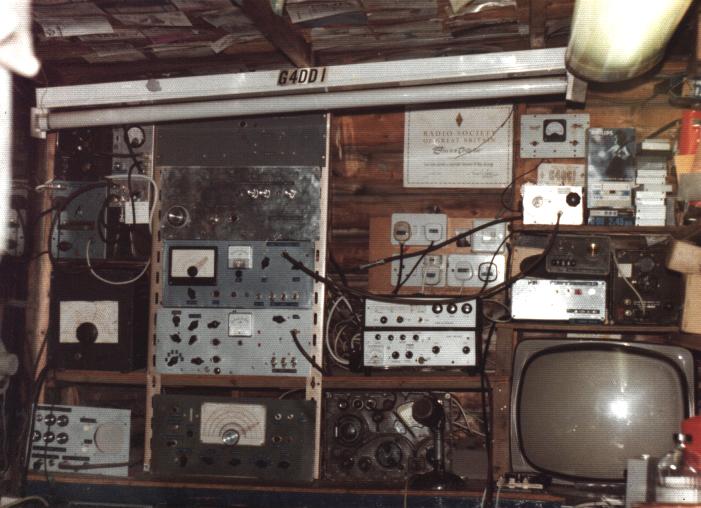 |
| The shack as it was in 1974 |
At this time, I was supposed to be revising for O-levels, but the time at home, when I should have been revising was spent making CW contacts on 20m with a homebrew CO-PA Tx, and on building a transmitter for Topband, which I still use today, on the Sunday AM net.
Interest in the schoolwork palled, and I got a Saturday job in a local TV shop, repairing transistor radios, and learning how to repair TV's. Eventually, to my father's, and teacher's, consternation, I forwent the chance of a place at university and went full time into the shop. The shop owner was one of the old school, he didn't suffer fools, and he taught me well how to deal with customers. A couple of years day release at Lincoln College of Technology got me the bits of paper I was supposed to need to succeed in life. The firm expanded, we built up a good servicing business that brought me a good living for many years, one that I may not have got had I followed the course intended for me.
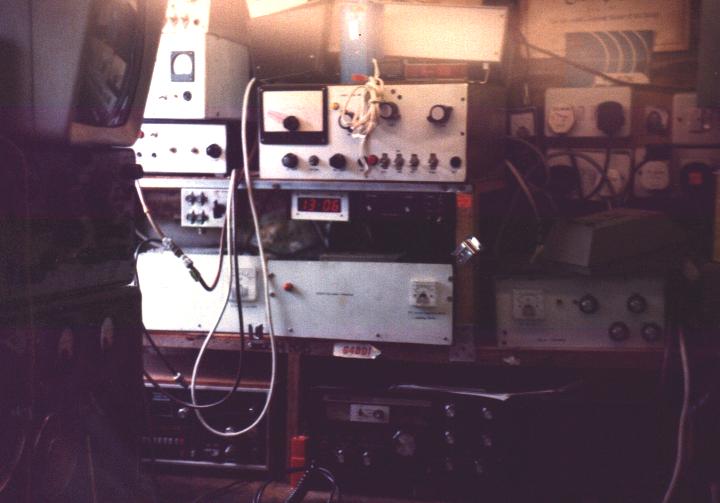 |
| and later, towards the end of 1975. Note the arrival of the commercial gear, Belcom FS1007 and Yaesu FT200! |
Back to the 19set and converter, I frequently came across amateurs talking to one another, the transmission seemed to be continuous, each over being interspersed with a "dah-di-dah". This was the first repeater in the country, GB3PI. Enquiries revealed that, to talk on a repeater, one had to transmit 600kc/s lower than one's receive frequency, and use FM. So the SCR522 was modified to FM.
In 1977, a meeting was held to form a repeater group in Lincolnshire, and as I had been experimenting with logic chips and microprocessors, I volunteered to design the control system for the repeaters. Two years later, this resulted in GB3SO, then GB3FR coming on air. The control systems I built remained in service until 1997.
After this, work, and interest in the female of the species, led to less time being spent on radio. I turned instead to a different kind of homebrewing, and, with my future XYL, Barbara (G8IEV), built my first house, complete with indoor shack.
Since then I have married, we have three rapidly growing children, and have moved to a more radio friendly location away from the town. A recent job and career change has meant that I have been able to spend more time on amateur radio and repair and restoration of vintage equipment. I have no time at all for the modern "black boxes" and their untrained operators, or "computer radio" preferring instead to experiment, and talk with others who are doing the same.
I don't think that todays newcomers to amateur radio (incidentally, I refuse to use that dreadful word h*m) will ever have the experiences that we old, and not so old, timers had. I'm pleased to say, however, that there are newcomers to the hobby who are interested in learning a little more about real radio and I am more than willing to help them in any way I can.
> Home